Updated April 05, 2024
A living will or health care directive allows a person (principal) to create end-of-life treatment preferences. The main purpose of a living will is used to direct medical staff on whether to provide or remove life-sustaining procedures.
A living will only becomes effective if a person is deemed to have a terminal or incurable condition.
By State
- Alabama
- Alaska
- Arizona
- Arkansas
- California
- Colorado
- Connecticut
- Delaware
- Florida
- Georgia
- Hawaii
- Idaho
- Illinois
- Indiana
- Iowa
- Kansas
- Kentucky
- Louisiana
- Maine
- Maryland
- Massachusetts
- Michigan
- Minnesota
- Mississippi
- Missouri
- Montana
- Nebraska
- Nevada
- New Hampshire
- New Jersey
- New Mexico
- New York
- North Carolina
- North Dakota
- Ohio
- Oklahoma
- Oregon
- Pennsylvania
- Rhode Island
- South Carolina
- South Dakota
- Tennessee
- Texas
- Utah
- Vermont
- Virginia
- Washington
- Washington D.C.
- West Virginia
- Wisconsin
- Wyoming
Table of Contents |
What is a Living Will?
A living will is a declaration that instructs medical staff on how to treat a person (declarant) in a terminal or incurable condition. The document will include whether the declarant accepts or rejects life-sustaining procedures.
Video
Statutory Forms
How to Make a Living Will (4 steps)
- Decide Treatment Options
- Choose End-of-Life Decisions
- Select a Health Care Agent (Optional)
- Sign Form
1. Decide Treatment Options
 Take a moment to reflect on what course of action you would like to take in the event of certain medical events that could occur such as:
Take a moment to reflect on what course of action you would like to take in the event of certain medical events that could occur such as:
- Alzheimer’s Disease;
- Dementia;
- Vegetative State;
- Coma; and
- Incapacitation.
Depending on your individual preference would you like to have the medical staff do everything possible to keep you alive? Or, would you rather die peacefully if you cannot breathe or eat on your own?
These are questions that should be discussed between you and your family so that in the unfortunate event this should happen you and your family will be ready. After careful discussion, the final decisions you make should be reflected in the document.
3. Select a Health Care Agent (Optional)
 Most living wills have the option of adding a health care agent to carry out the patient’s intended wishes. This is helpful in the event that there is a gray area where maybe the agent selected feels there is a good chance for survival and will opt against a decision made in the living will. Otherwise, the Principal can choose to neglect this portion of the document and have doctors and medical staff specifically adhere to what is written in the living will.
Most living wills have the option of adding a health care agent to carry out the patient’s intended wishes. This is helpful in the event that there is a gray area where maybe the agent selected feels there is a good chance for survival and will opt against a decision made in the living will. Otherwise, the Principal can choose to neglect this portion of the document and have doctors and medical staff specifically adhere to what is written in the living will.
| State | Signing Requirements | Statute |
| Alabama | Two (2) witnesses | § 22-8A-4(c)(4) |
| Alaska | Two (2) witnesses or a notary public | AS 13.52.010(b) |
| Arizona | One (1) witness or a notary public | § 36-3261(b) |
| Arkansas | Two (2) witnesses or a notary public | § 20-17-202(a)(1) |
| California | Two (2) witnesses or a notary public | PROB § 4701 |
| Colorado | Two (2) witnesses or a notary public | § 15-18-106(1) |
| Connecticut | Two (2) witnesses | § 19a-575 |
| Delaware | Two (2) witnesses | § 2503(b) |
| Florida | Two (2) witnesses | § 765.302(1) |
| Georgia | Two (2) witnesses | § 31-32-5(c)(1) |
| Hawaii | Two (2) witnesses or a notary public. | § 327E-3(b) |
| Idaho | The Principal is the only required signer. Although, the State of Idaho recommends it to be witnessed or notarized. | § 39-4510 |
| Illinois | Two (2) witnesses | 755 ILCS 35/3 |
| Indiana | Two (2) witnesses | IC 16-36-4-10 |
| Iowa | Two (2) witnesses or a notary public | § 144.A.3(2) |
| Kansas | Two (2) witnesses | § 65-28,103 |
| Kentucky | Two (2) witnesses or a notary public | § 311.625(2 |
| Louisiana | Two (2) witnesses | § 1151.2(A)(2) |
| Maine | Two (2) witnesses | § 5-803(2) |
| Maryland | Two (2) witnesses | § 5-602(c) |
| Massachusetts | No requirements | No statute |
| Michigan | No requirements | No statute |
| Minnesota | Two (2) witnesses or a notary public | § 145C.03 |
| Mississippi | Two (2) witnesses or a notary public | § 41-41-209 |
| Missouri | Two (2) witnesses | 459.015(4) |
| Montana | Two (2) witnesses | § 50-9-103 |
| Nebraska | Two (2) witnesses or a notary public | 20-404(1) |
| Nevada | Two (2) witnesses | NRS 449A.439 |
| New Hampshire | Two (2) witnesses or a notary public | § 137-J:14 |
| New Jersey | Two (2) witnesses or a notary public | § 26:2H-56 |
| New Mexico | Principal only. Although in § 24-7A-4(Part 3)) states that “two (2) witnesses are recommended” | (§ 24-7A-2(B), § 24-7A-4(Part 3)) |
| New York | Two (2) witnesses | PBH § 2981 |
| North Carolina | Two (2) witnesses and a notary public | § 90-321(c) |
| North Dakota | Two (2) witnesses or a notary public | § 23-06.5-05 |
| Ohio | Two (2) witnesses or a notary public | Section 2133.02(B) |
| Oklahoma | Two (2) witnesses | § 63-3101.4 |
| Oregon | Two (2) witnesses or a notary public | ORS 127.515(2)(b) |
| Pennsylvania | Two (2) witnesses | § 54-5442(b) |
| Rhode Island | Two (2) witnesses | § 23-4.11-3(a) |
| South Carolina | Two (2) witnesses and a notary public | § 44-77-40(2) |
| South Dakota | Two (2) witnesses and a notary public | § 34-12D-2 |
| Tennessee | Two (2) witnesses or a notary public | § 68-11-1803(b) |
| Texas | Two (2) witnesses or a notary public | § 166.154, § 166.003 |
| Utah | One (1) disinterested witness | § 75-2a-107(c) |
| Vermont | Two (2) witnesses | 18 V.S.A. § 9703 |
| Virginia | Two (2) witnesses | § 54.1-2983 |
| Washington | Two (2) witnesses or a notary public | RCW 70.122.030(1) |
| Washington D.C. | Two (2) witnesses | 7-622(a)(4) |
| West Virginia | Two (2) witnesses or a notary public | § 16-30-4(a) |
| Wisconsin | Two (2) witnesses | § 154.03(1) |
| Wyoming | Two (2) witnesses or a notary public | § 35-22-403(b) |
Sample
Download: PDF, MS Word, OpenDocument
HEALTH CARE DIRECTIVE (LIVING WILL)
I, [FULL NAME] (“Principal”), want everyone who cares for me to know what health care I want when I cannot let others know what I want.
SECTION 1:
I want my doctor to try treatments that may get me back to an acceptable quality of life. However, if my quality of life becomes unacceptable to me and my condition will not improve (is irreversible), I direct that all treatments that extend my life be withdrawn.
A quality of life that is unacceptable to me means (check all that apply):
☐ – Unconscious (chronic coma or persistent vegetative state)
☐ – Unable to communicate my needs
☐ – Unable to recognize family or friends
☐ – Total or near total dependence on others for care
☐ – Other: [OTHER]
Check only one:
☐ – Even if I have the quality of life described above, I still wish to be treated with food and water by tube or intravenously (IV).
☐ – If I have the quality of life described above, I DO NOT wish to be treated with food and water by tube or intravenously (IV).
SECTION 2: (You may leave this section blank)
Some people do not want certain treatments under any circumstance, even if they might recover. Check the treatments below that you do not want under any circumstances:
☐ – Cardiopulmonary Resuscitation (CPR)
☐ – Ventilation (breathing machine)
☐ – Feeding tube
☐ – Dialysis
☐ – Other: [OTHER]
SECTION 3:
When I am near death, it is important to me that: [LIST PREFERENCES]
(This section may include preferences such as hospice care, place of death, funeral arrangements, cremation, or burial selections)
As the principal, I fully understand my rights regarding this living will and the availability of health care treatment options. I have made my selections above of my free will and without coercion from any 3rd party.
Principal’s Signature: ___________________________ Date: ____________
Print Name: ___________________________
Source: https://www.hov.org/media/1112/living-will_forms.pdf
How to Write
Download: PDF, MS Word (.docx), or OpenDocument (.odt).
(1) Documentation Date. Attending Physicians and Medical Professionals charged with your care will require the most recent declaration you have made regarding your treatment preferences. Once you have completed this issue, return to the first statement then record the day you have signed this document.

(2) Declarant Name. Several topics of discussion in this directive can have a significant impact on one’s health care. Since this paperwork will be referred to when a Patient is unable to communicate while enduring a serious medical condition that cannot be cured or that he or she will not recover from, it will be important that Reviewing Physicians are positive of the Declarant issuing this directive. To identify yourself as the Declarant, you must record your full name to the first article and provide some supporting information where requested.
(3) Declarant Mailing Address.
(4) Declarant Social Security Number.

A. Life SupportUnacceptable Quality Of Life
(5) Chronic Coma Or Persistent Vegetative State. This document can be utilized as an instrument to describe what you consider an intolerable quality of life to Physicians when you cannot speak or otherwise make such thoughts and beliefs known. For instance, if you wish Physicians to know that you believe a lifelong coma or being in a permanent vegetative state is an unacceptable way to live then initial the statement on this topic and place an “x” in the corresponding checkbox. If you do not wish to make such a statement to Physicians who may need to review this paperwork in the future, then do not mark it.
(6) No Longer Able To Communicate My Needs. Some medical conditions will leave you in a state where you are aware of your surroundings and those around you but lack the ability to communicate. If you wish Medical Professionals to be aware that such a result from any condition will not be considered a recovery because you do not believe you could live this way, then initial the second statement presented.
(7) No Longer Able To Recognize Family Or Friends. If your quality of life is strongly related to being able to recognize the people around you as family or friends then you can inform Physicians that a loss of this ability will be too debilitating to be labeled a recovery. To label the inability to recognize friends and family as an intolerable quality of life, initial the third statement.

(8) Total Dependence On Others For Daily Care. The fourth statement of this area will identify being totally dependent on other people for day-to-day self-care activities (i.e. getting dressed, bathing, brushing teeth, eating, traveling, etc) as being an intolerable quality of life. Initial this statement to let Physicians treating you in the future that such a state would be considered an unacceptable level of living.
(9) Other. If there are activities, lifestyles, or basic qualities that you cannot live without (i.e. vision or the ability to move your limbs) then use the area provided in the final statement (“Other”) to discuss them. This item must be initialed and selected to be considered a valid statement.

Nourishment And Hydration
(10) Requesting Medically Delivered Nourishment And Fluids. Now that you have defined what you believe are unacceptable losses to your abilities to survive or maintain a comfortable and tolerable lifestyle, a discussion on how Physicians should treat you when suffering the debilitations mentioned in the previous section must ensue. The first topic concerns the medical delivery of nutrients and water/fluids. If you have an intolerable quality of life and wish to receive nutrients and water/fluids even though medical technology will be needed to deliver them to your system then initial the first statement made.
(11) Refusing Artificially Delivery Of Nourishment And Fluids. If you will be stricken with an intolerable quality of life from an untreatable medical condition, then (in many states) you will have the option of denying medically delivered nutrition and water/fluids when you can no longer gain nourishment or hydration without the aid of medical technology. To make this statement, initial the second statement.

B. Certain Life-Sustaining Treatment
(12) Cardiopulmonary Resuscitation. The use of cardiopulmonary resuscitation is considered standard procedure when one’s lungs and/or heart seize or become ineffective. This system delivers oxygenated blood to the brain, thus when it fails death can occur soon. If you do not wish CPR (cardiopulmonary resuscitation) applied as a reaction to your heart and/or lungs stopping, then initial the first statement in Section B. Make sure to mark the checkbox presented with this statement as well.
(13) Ventilation (Breathing Machine). Quite a few medical conditions will result in being unable to physically inhale or exhale. This may be from a blockage or internal trauma to the airway, lungs, and/or surrounding tissues. In many cases, Physicians can use medical technology to help you breathe as a response to such a condition. If you do not wish to be connected to a breathing machine even if this means you will asphyxiate then submit your initials and select the appropriate checkbox to the second statement of Section B.

(14) Feeding Tube. You can deny the use of a feeding tube under any circumstances by initialing the third definite of this list.
(15) Dialysis. The fourth topic, “Dialysis,” is a procedure used to support your kidneys’ function by removing blood toxins that must be excreted. You can refuse the application of dialysis regardless of how this will effect your health or longevity by initialing the appropriate line and marking the corresponding checkbox.
(16) Other. Some states will allow you to refuse quite a few treatments. The above list constitutes the most common treatments that may require consent or can be denied under certain circumstances by the Patient. If there are other medical procedures or medications that you wish to refuse under any circumstances then list them after the word “Other.” You may also title an attachment with this information then present the attachment title on this line. This option must be initialed and check marked or selected to be applied as your directives in this document.

C. End Of Life Wishes
(17) Near Death Requests. If there are any preferences that you wish considered when you are near death then use Section C to present them. Here, you may present requests for a hospice, specific care or treatment, the preference to die at home, your memorial preferences, your religious concerns, organ donation, and any other topic that is important to you.

II. Health Care (Medical Power Of Attorney With Mental Health Authority
(18) Principal Name. A second action can be taken with this directive. You may use it to name a specific (and trusted) Family Member and/or Friend to make medical decisions on your behalf when you do not have the ability to make them yourself or when you cannot communicate your medical instructions effectively. To begin this process, identify yourself as the Patient or the Principal who is issuing this designation.
(19) Medical And Mental Health Care Attorney-in-Fact. While, in most states, there are no formal requirements for your Medical or Mental Health Attorney-in-Fact so long as he or she is an adult, there are several basic attributes he or she must have. Your Medical Attorney-in-Fact or Mental Health Care Attorney-in-Fact will be approved by you to take the reigns in consulting and determining with Physicians what the next steps of your treatment should be. This is a useful precaution so long as the Party you designate is trustworthy, reliable, and kept informed on your medical preferences. Determine who this Person is then, so long as they agree to this responsibility, name them as your Medical or Mental Health Care Attorney-in-Fact on the blank line provided in the designation statement.

(20) Phone Number And Address Of Agent.

Specific Consent For Agent Actions
(21) Admittance Power. Several decisions will be in the hands of your Medical and Mental Health Care Attorney-in-Fact. Depending on the state, this Agent can represent you in manners not only effecting your treatment, but also your admittance to mental health care facilities so long as you have given him or her the consent to do so. Initial the appropriate statement to give your Medical and Mental Health Care Attorney-in-Fact the consent and power Medical Professionals must see to allow him or her to admit you to inpatient psychiatric care.
(22) Durability Of Directive And Designation. In some cases, interested Parties may seek to overturn your Agent’s decisions or those that you put forth in the directive above. To prevent this and declare this as a durable issue even when you are incapacitated, the second statement must bear your initials.

(23) Successor Agent Name And Contact Information. If your Medical or Mental Health Care Attorney-in-Fact cannot fulfill this role, will not fulfill this role, or cannot be reached to do so, then Physicians may be left without direction when you are incapacitated. By naming a Successor Agent in this document, you will be approving a specific Party as a Back-up or Reserve Agent who may be reached and requested to act as your Medical or Mental Health Care Attorney-in-Fact (by Physicians) should this role become vacant while you are incapacitated. Make this appointment by documenting the Successor Agent’s complete name, address, and current telephone number to the appropriate declaration.

Directive Execution
(24) Formal Signature Date. It will be considered imperative that Physicians have the latest version of your directives. Therefore, document the current date when you are ready to execute your signature.
(25) Principal Declarant Signature. Sign your name to this declaration. The signature requirements for this document vary from state to state, thus, it is recommended that you sign your name before two Witnesses and a Notary Public.
(26) Printed Name.
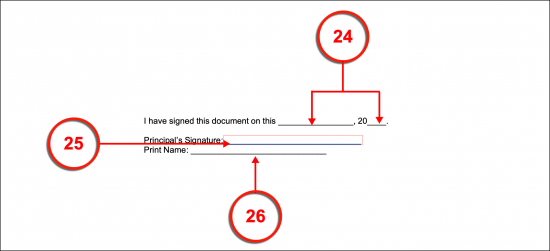
Signature Verification
(27) Witness 1 Signature And Name. You may choose to have two Witnesses verify your signature, a Notary Public authenticate your signature, or both. Regardless of a Notary Public’s level of involvement, if two Witnesses are present then each must read the “Witness Acknowledgment” provided. The first Witness, or Witness 1, should sign his or her name and print it upon determining that the statement is accurate.
(28) Witness 1 Phone And Address.
(29) Witness 2 Signature And Name. The second Witness, or Witness 2, will also need to testify that the acknowledgment statement is true by signing and printing his or her name in the signature area provided.
(30) Witness 2 Phone And Address.

Notary Acknowledgment
(31) Notary Public. Since Witnesses tend to be Private Citizens, reaching them in the future can be difficult. This can be problematic in health care since time can be an issue. Thus, if possible, notarize your signature by signing this document before a Notary Public. He or she will give directions appropriate to the notarization process, then show proof of its completion in the “Notary Acknowledgment” section.
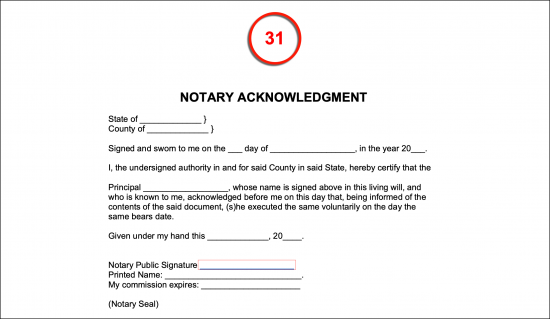

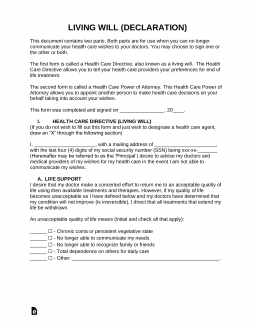
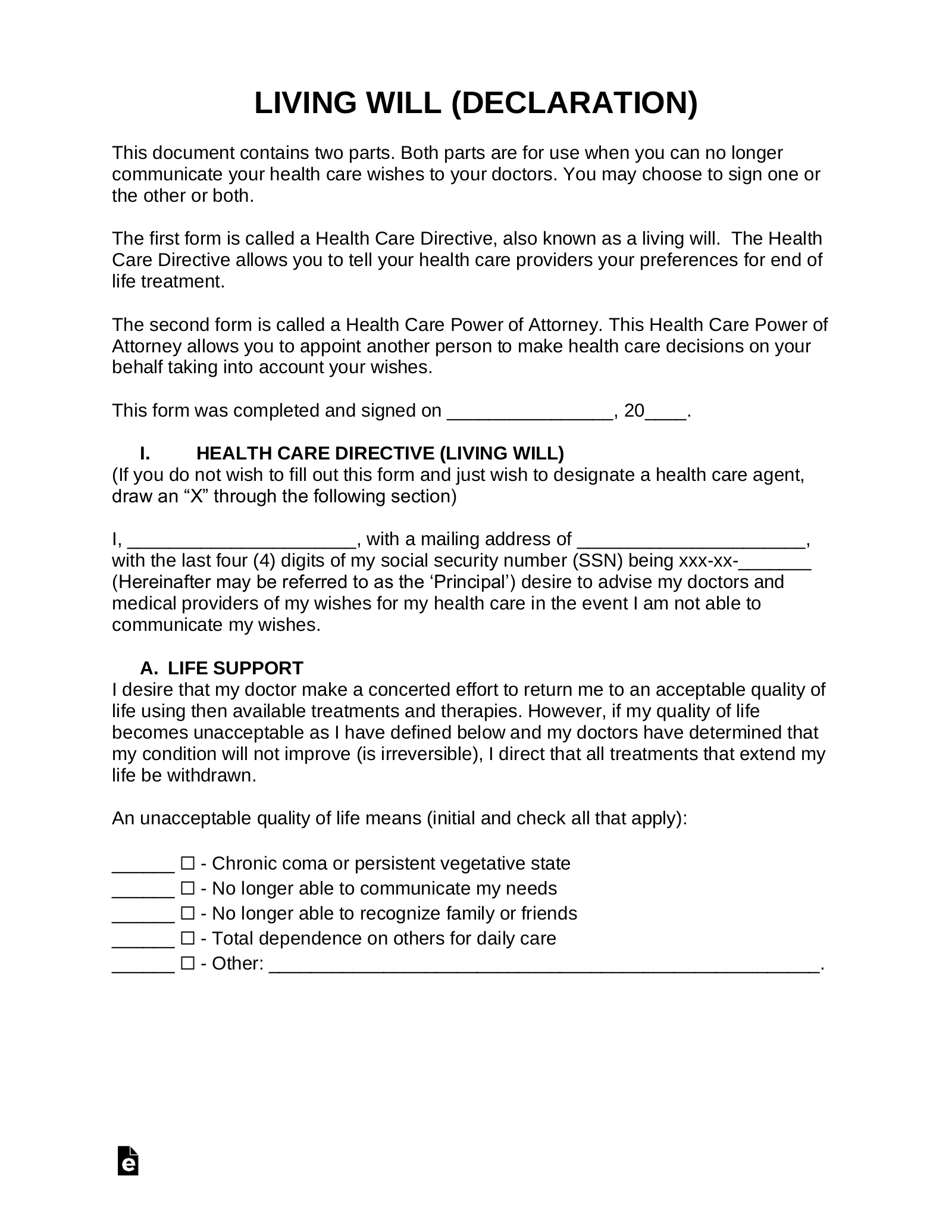
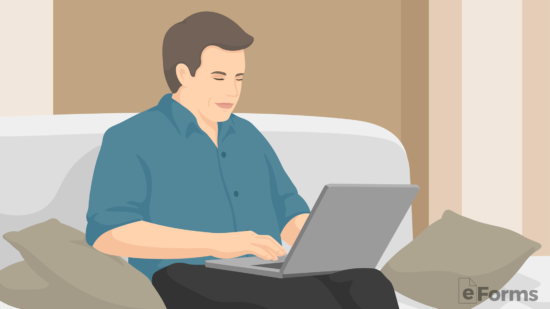 If there are any other decisions besides medical care that you would like such as a priest or religious person saying your last rights or specific funeral plans you would like to make it is best to have written to be carried out by your family.
If there are any other decisions besides medical care that you would like such as a priest or religious person saying your last rights or specific funeral plans you would like to make it is best to have written to be carried out by your family.